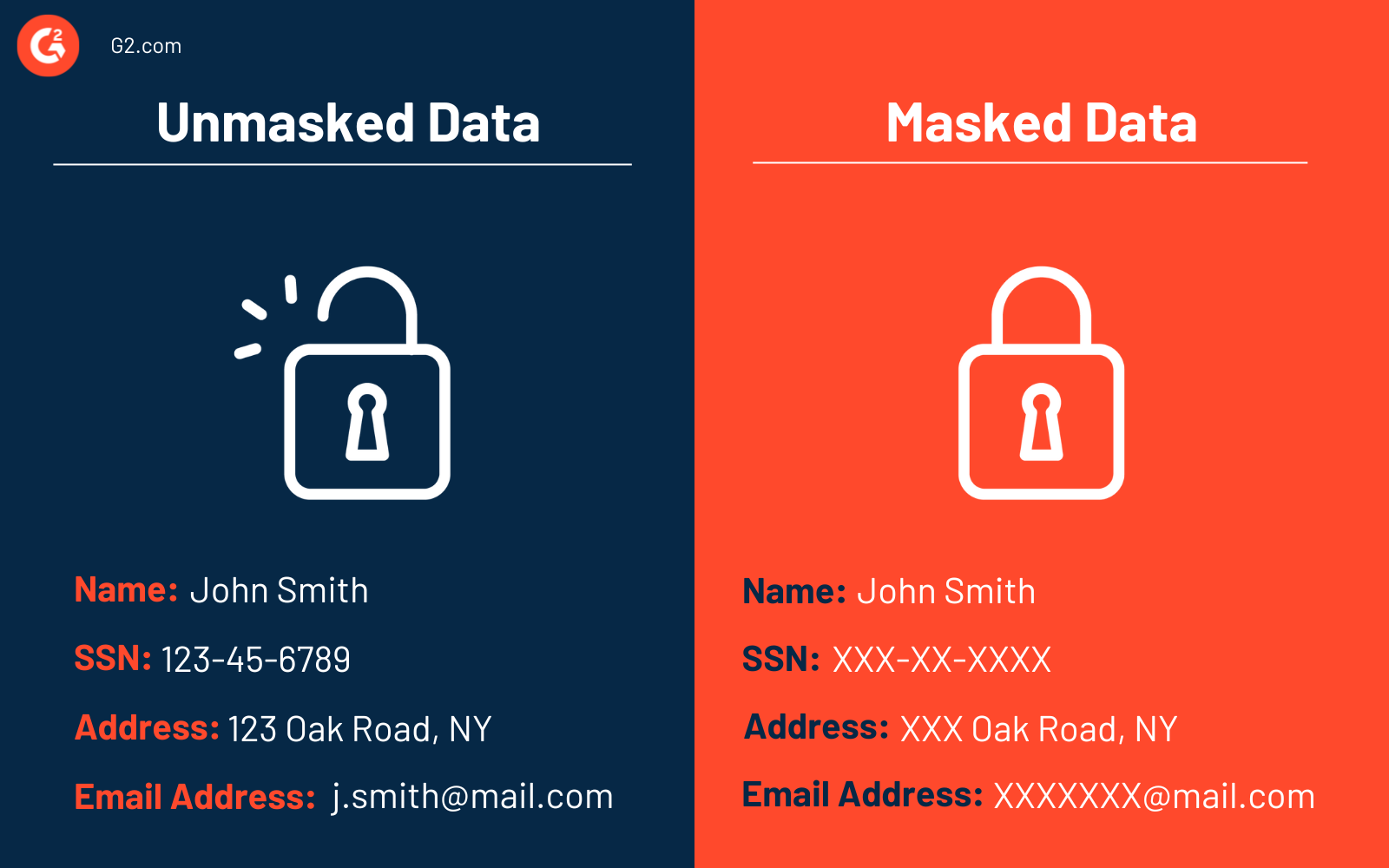Businesses are constantly entrusted with sensitive customer information, such as financial and biometric information, and with personal data comes great responsibility to ensure privacy and confidentiality.
Enter data masking, the well-guarded technique against prying eyes and security threats.
What is data masking?
Data masking refers to modifying or substituting original sensitive data to protect it from unauthorized eyes while preserving its usefulness for authorized users in production and test environments.
Data masking software helps organizations protect their data. These tools encrypt data, provide consistent masking methods, and allow the application and removal of masks based on specific rules.
Why is data masking important?
Data masking plays a crucial role in protecting sensitive information from security risks such as data breaches and cyber-attacks. If a security breach occurs, data masking helps by ensuring that the exposed data is not real or sensitive, thereby reducing the impact of the breach.

Since the masked data is a fictional representation of the original information, even if attackers gain access, they won't be able to misuse the data for malicious purposes, such as identity theft or fraud. This adds an extra layer of security, protecting the actual sensitive data and minimizing potential damage from the breach.
Möchten Sie mehr über Datenmaskierungssoftware erfahren? Erkunden Sie Datenmaskierung Produkte.
Data masking use cases
Data masking is widely used across various industries to protect sensitive information while maintaining data utility. Here are the key use cases:
Compliance with data privacy regulations
Organizations use data masking to comply with data privacy laws, such as the General Data Protection Regulation (GDPR). This protects sensitive information, including personally identifiable information (PII), financial records, protected health information (PHI), and intellectual property.
For example, healthcare providers mask patient data to meet Health Insurance Portability and Accountability Act (HIPAA) requirements while sharing information for research.
Secure software development and testing
Data masking is employed in software development and testing environments to ensure that sensitive information is not exposed. Software developers and testers use masked datasets that mimic real-world data without revealing actual personal or financial details.
Analytics and research
Data masking is used by data scientists and researchers to analyze large datasets while preserving privacy. For example, pharmaceutical companies may mask patient medical documents in clinical trials to study drug efficacy without compromising individual privacy.
Employee training
Data masking is applied in employee training sessions to provide realistic scenarios without exposing genuine data. Organizations use masked data to train employees on handling customer inquiries or processing transactions.
For example, a bank might use masked transaction data in training programs to teach employees how to detect fraud.
Role-based access control
Data masking is used to enforce role-based access control within organizations. Employees can access only the data necessary for their roles, with sensitive information masked to prevent unauthorized viewing.
For example, in a hospital setting, administrative staff might see masked patient electronic health records while doctors have access to complete information.
Test data management
Data masking is used to generate secure test data quickly, ensuring that testing environments do not expose sensitive information. Automated masking tools integrate with existing systems to produce high-quality test data.
For instance, an insurance company might use masked policyholder information to test new insurance claims processing systems without risking data exposure.
Types of data masking
Businesses can use several types of data masking to secure and protect sensitive data sets.
Static data masking (SDM)
Static data masking (SDM) involves applying a fixed set of masking rules for sensitive data before sharing or storing it. It directly alters the data with anonymized values through encryption or anonymization techniques.
The same masking method is used across all users and applications that access the data. SDM is generally good for data that remains unchanged and will be used repeatedly, such as in an ongoing test environment.
Dynamic data masking (DDM)
Dynamic data masking (DDM) involves applying masking techniques in real time and dynamically altering sensitive data during application or execution. DDM is prevalent in production systems and for users, such as testers, who need access to actual data for analysis.
Dynamic data is used for role-based security access. For example, a user requests data in the database, and masking rules are applied based on the user’s role or access permissions — authorized users receive the original data set, and unauthorized users get the masked data.
Deterministic data masking
Deterministic data masking involves mapping data to ensure a value is always replaced by another value in the database. For example, if you masked a name with “Bob,” the original name would appear as “Bob” everywhere throughout the dataset.
While deterministic data masking is convenient, it’s not as convenient as other masking types. If someone could decode who “Bob” is in the example above, they would be able to identify that individual’s information throughout the dataset.
On-the-fly data masking
On-the-fly data masking masks sensitive information as it moves between environments by masking it in memory rather than storing an altered set of data in memory rather than storing it separately.
Organizations can use this technique to mask data as it moves between environments, from production to the test environment. This technique is ideal for continuous software development or complex integration scenarios where teams frequently transfer data between production and non-production environments.
Statistical obfuscation
The statistical obfuscation method alters sensitive data while preserving statistical properties and relationships within the data.
It allows for applying mathematical functions and algorithms to the data for statistical analysis once masked by ensuring that the masked data maintains its original patterns, correlations, and overall distribution.
Data masking techniques
Depending on your database and needs, there are different techniques for masking data within the various types of data masking.
Encryption
Encryption masking combines encryption and data masking to protect sensitive information. Using this approach, you can encrypt sensitive data with cryptographic algorithms, making it unreadable to everyone except authorized users with decryption keys.
Encryption masking provides high data security but can be a bottleneck that slows down the data analysis since users must use decryption keys whenever they want to access the data.
Top 5 encryption software tools:
* These are the top 5 encryption software tools based on G2’s Spring 2024 Grid® ReportShuffling
Shuffling data is what it sounds like — randomizing data points within a given data set. It preserves the relationship and statistical properties within the dataset while making individual records unreadable. The data values don’t change, but the order in which they appear related does.
For example, if you’re working with a data table that includes customer names and credit card numbers, the output data set would consist of a shuffled table of the actual customer names and credit card numbers that don’t go together.
Substitution
Substitution data masking involves replacing sensitive data points with similar but substituted fictitious data.
For example, if you’re working with names, you could replace real names with randomly generated ones so the name value still looks like a name. The same would work with credit card numbers. The output data set would include credit card numbers of the same string length but random numerical values instead of real ones.
Nulling
Some teams use the nulling technique to render data unreadable and unusable. Nulling involves applying “null” values to data columns so unauthorized users don’t see any data. While this method protects data, it can also be problematic because those needing access to the data likely won’t be able to use it unless the “null” values are wholly irrelevant to the analysis or test.
Hashing
Finally, hashing converts data points into obfuscated, fixed-length string values. It’s commonly used for safeguarding information like passwords, as the original information isn’t needed to perform the work.
In other words, data users don’t need to know individuals’ actual passwords, but they need to test a function that requires the user to enter a password or have one.
Challenges in data masking
Data masking is important. However, it comes with several challenges that need to be addressed to ensure effective data security and integrity. Here are some common issues encountered in data masking:
Attribute preservation
Data masking needs to keep the same types of data and their patterns. For example, if you mask customer ages, the range and spread of ages should remain similar. If not done correctly, it can affect how well your analysis or reports reflect reality.
Semantic integrity
The fake data created during masking should still make sense. For instance, if you mask employee salaries, the new values should still fit within typical salary ranges. Similarly, masked phone numbers should look real. This helps ensure the masked data is still useful and realistic.
When masking data for testing, it’s important that the fake data still follows the rules for things like email formats or credit card numbers. If the data doesn’t match these rules, it can cause errors during testing.
Similarly, when the original data needs to be unique, like social security numbers, the masked data should be unique too. If the new values aren't unique, it can lead to confusion or errors.
Referential integrity
Masked data should keep its relationships consistent. For example, if you replace a customer’s name with a fake one, that same fake name should be used everywhere it appears. This helps maintain accurate connections between data records.
Data masking best practices
To do data masking right, it's important to follow some best practices that ensure the data stays protected while still being useful. Here are some key tips to help you mask data effectively and securely.
Define the project scope
To implement effective data masking, start by determining what information needs protection, who is authorized to access it, and which applications use the data and its locations in both production and non-production environments.
Maintain referential integrity
Referential integrity requires that all data of a specific type be masked consistently using the same algorithm. In large organizations, a single data masking tool across the enterprise may not be practical due to differing budgetary constraints, IT practices, and regulatory requirements. So, ensure synchronization of data masking tools and practices across the organization to avoid integration issues later on.
Protect data masking algorithms
Only authorized personnel should have access to the data masking algorithm's sensitive components. Knowledge of repeatable masking algorithms could lead to reverse engineering of sensitive information.
Best practices include enforcing separation of duties, where IT security defines methods and algorithms, but relevant department data owners manage specific settings and data lists.
Organize and track sensitive data
Enterprise data is dispersed across various technologies and locations. Unstructured data such as images, PDFs, and text-based files must also be protected.
For instance, replace images of sensitive documents like passports, driver’s licenses, and contracts with fake alternatives. Optical character recognition (OCR) can assist in detecting and masking sensitive content in such files.
Accurately locating and classifying sensitive data that requires protection is essential. Implement comprehensive tracking to ensure that the right data is masked appropriately.
Ensure compliance and security
Access to masked data should adhere to security policies regarding roles, locations, and permissions. Verify that data masking techniques align with security policies and regulations.
Evaluate and test data masking
Assess the effectiveness of data masking techniques regularly to ensure they provide the required security levels. Conduct tests to confirm that query results from masked data are comparable to those from the original data, ensuring consistency and reliability.
Top 5 data masking software tools
Data masking software tools help businesses protect their data by masking it through randomization and other techniques. Most importantly, these tools enable companies to continue using their data, but they render it unusable to parties outside the organization.
To qualify for inclusion in the data masking category, a product must:
- Encrypt data by masking it behind random characters or other data
- Allow the application and removal of a mask at will
- Provide consistent or random masking
* Below are the top five leading data masking software platforms from G2’s Spring 2024 Grid® Report. Some reviews may be edited for clarity.
1. Oracle Data Safe
Oracle Data Safe is a unified control center specifically for Oracle Databases. It helps users understand their data’s sensitivity, evaluate security risks, mask data for use, and monitor security and access controls.
Users can take advantage of security assessments, user assessments, activity auditing, alert enablement for signaling unusual behavior, data masking with preserved data integrity, and SQL firewall.
What users like best:
“What I liked most about Oracle Data Safe is that it is very helpful for auditing the data automatically. It manages the data itself and provides the best level of security. It helped our organization to meet the client or business requirements and provide a better output with the classified report.”
- Oracle Data Safe Review, Shivam T.
What users dislike:
“I found the prices to be on the higher side, so to have an economy of scale, one has to deploy it in every project one uses. Otherwise, I found this tool very useful.”
- Oracle Data Safe Review, Chitrang S.
2. Informatica Dynamic Data Masking
Informatica Dynamic Data Masking controls unauthorized access to production environments using data de-identification. It masks sensitive information to users based on their role-based access permissions, which include their role, location, and privileges. Additionally, it can alert unauthorized access attempts.
What users like best:
“Informatica data masking offers various techniques to protect sensitive data. With the help of their format-preserving technique, we protected the data without changing the format. Additionally, their dynamic data discovery technique identified most of the sensitive data fields. Overall, I can say Informatica is a comprehensive solution with a robust and user-friendly experience in anonymizing data.”
- Informatica Dynamic Data Masking Review, Mayank J.
What users dislike:
“It is a bit complex to understand initially, and slightly less documentation is available. But once you get a little idea, it is very easy and convenient to use it for masking and other security purposes.”
- Informatica Dynamic Data Masking Review, Himanshu G.
3. Informatica Data Security Cloud
Informatica Data Security Cloud uses authentication and encryption methods to ensure data security in cloud-native environments. It’s part of the Intelligent Data Management Cloud (IDMC) and is designed to run in the cloud.
What users like best:
“Master data management is the most valuable feature I like about Informatica Cloud. We can write code to build our own logic to verify the quality and use data masking. The API management and integration are good connectors provided with the software.
- Informatica Data Security Cloud Review, Gaurav K.
What users dislike:
“While the tool grants many options and features for data security, the people handling it need to undergo extensive and periodic training on GDPR, laws, regulations, etc., to manage the security and use the tool to its full capability.”
- Informatica Data Security Cloud Review, Vibha K.
4. Satori Data Security Platform
Satori Data Security Platform enables self-service data and analytics controls. Users have personal data portals where they gain immediate access to data sets that are relevant to them based on access policies and controls. Satori anonymizes data dynamically for a scalable solution across multiple permission-based profiles and policies.
What users like best:
“Satori offers a user-friendly interface, making it easy to implement and navigate, robust data masking and security features, and protecting sensitive data. Automated and scalable access control, allowing organizations to have granular control over data access, seamlessly integrates with popular software tools like Snowflake and Looker, simplifying the integration process.”
- Satori Data Security Platform Review, Vaibhav S.
What users dislike:
“It can be integrated with almost all software, especially on the cloud, which makes it indispensable. However, performance becomes a bit slow when tons of terabytes of data are fed into the system, both in terms of performance and time to generate the results.”
- Satori Data Security Platform Review, Heena R.
5. Clonetab
Clonetab is a virtualization and cloning platform for data delivery. It offers advanced data scrambling (ADS), which obfuscates sensitive data before release, and extensive backup and data recovery solutions for Oracle e-Business Suite, PeopleSoft, and SAP Hana databases.
What users like best:
“Clonetab not only helps the administrators with cloning big VMware but also helps them to clone databases at a granular level. The GUI for Clonetab is made so that it’s easy for administrators to work around it.”
- Clonetab Review, Nikhil N.
What users dislike:
“Despite being the best platform for every business's everyday needs, it has less community support, which means that this platform is entirely dependent on support staff, which may result in unintentional delays. If we could have a community edition of this platform, it would be simple to rectify quickly with the community's help.”
- Clonetab Review, Mukesh P.
Can you read the data?
Data masking is an effective technique for safeguarding personal and confidential information. Businesses use data masking to secure and protect sensitive data when transferring it between various testing, production, and development environments. Many data masking types and techniques are available for businesses to choose from to protect the information they are working with.
Discover how data loss prevention can safeguard your sensitive information.

Alyssa Towns
Alyssa Towns works in communications and change management and is a freelance writer for G2. She mainly writes SaaS, productivity, and career-adjacent content. In her spare time, Alyssa is either enjoying a new restaurant with her husband, playing with her Bengal cats Yeti and Yowie, adventuring outdoors, or reading a book from her TBR list.


.png)